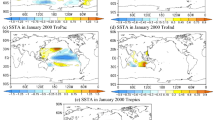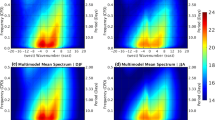Abstract
We compare 45 years of the reanalyses of National Center for Environmental Prediction–National Center for Atmospheric Research and European Center for Mid-Range Weather Forecast in terms of their representation of the mid-latitude winter atmospheric variability for the overlapping time frame 1957–2002. We adopt the classical approach of computing the Hayashi spectra of the 500 hPa geopotential height fields and we introduce an ad hoc integral measure of the variability observed in the Northern Hemisphere on different spectral subdomains. Discrepancies are found especially in the pre-satellite years of the records in the high frequency-high wavenumber propagating waves. This implies that in the pre-satellite period the two datasets have a different representation of the baroclinic available energy conversion processes. Minor differences are also found in the description of low frequency–low wavenumber standing waves. We observe a positive impact of the satellite data on the representation of wave activity over the oceanic sectors in the period starting from 1979, in particular on the description of high frequency variability. Since in the pre-satellite period the assimilated data are more scarce, predominately over the oceans, and of lower quality than found later on, they provide a weaker constraint to the model dynamics. Therefore, the resulting discrepancies in the reanalysis products may be mainly attributed to differences in the models’ behaviour.







Similar content being viewed by others
References
Andersson E, Haseler J, Undén P, Courtier P, Kelly G, Vasiljevic D, Brancovic C, Cardinali C, Gaffard C, Hollingsworth A, Jakob C, Janssen P, Klinker E, Lanzinger A, Miller M, Rabier F, Simmons A, Strauss B, Thépaut JN, Viterbo P (1998) The ECMWF implementation of three-dimensional variational assimilation (3D-Var). Part III: experimental results. Q J R Meteorol Soc 124:1831–1860
Barry L, Craig GC, Thuburn J (2000) A GCM investigation into the nature of baroclinic adjustment. J Atmos Sci 57:1141–1155
Bengtsson L, Hagemann S, Hodges KI (2004a) Can climate trends be calculated from reanalysis data? J Geophys Res 109:D11111. 10.1029/2004JD004536
Bengtsson L, Hodges KI, Hagemann S (2004b) Sensitivity of the ERA40 reanalysis to the observing system: determination of the global atmospheric circulation from reduced observations. Tellus 56A:456–471
Benzi R, Speranza A (1989) Statistical properties of low frequency variability in the Northern Hemisphere. J Clim 2:367–379
Benzi R, Malguzzi P, Speranza A Sutera A (1986) The statistical properties of general atmospheric circulation: observational evidence and a minimal theory of bimodality. Q J Roy Met Soc 112:661–674
Blackmon ML (1976) A climatological spectral study of the 500 mb geopotential height of the Northern Hemisphere. J Atmos Sci 33:1607–1623
Blackmon ML, Wallace JM, Lau NC, Mullen SL (1977) An observational study of the Northern Hemisphere wintertime circulation. J Atmos Sci 34:1040–1053
Brankovic C, Molteni F (2004) Seasonal climate and variability of the ECMWF ERA-40 model. Clim Dyn 22:139–155
Buzzi A, Trevisan A, Speranza A (1984) Instabilities of a baroclinic flow related to topographic forcing. J Atmos Sci 41:637–650
Caires S, Sterl A, Bidlot JR, Graham A, Swail V (2004) Intercomparison of different wind wave reanalyses. J Clim 17:1893–1913
Charney JG, DeVore JG (1979) Multiple flow equilibria in the atmosphere and blocking. J Atmos Sci 36:1205–1216
Charney JG, Straus DM (1980) Form-drag instability, multiple equilibria and propagating planetary waves in the baroclinic, orographically forced, planetary wave system. J Atmos Sci 37:1157–1176
Courtier P, Thépaut JN, Hollingsworth A (1994) A strategy for operational implementation of 4D-Var, using an incremental approach. Q J R Meteorol Soc 120:1367–1388
Courtier P, Andersson E, Heckley W, Pailleux J, Vasiljevic D, Hamrud M, Hollingsworth A, Rabier F, Fisher M (1998) The ECMWF implementation of three dimensional variational assimilation (3D-Var). I: Formulation. Q J R Meteorol Soc 124:1783–1807
Dell’Aquila A (2004) Midlatitude winter tropopause: the observed state and a theory of baroclinic adjustment. PhD Thesis University of Genoa, pp 100
Dickson R, Lazier J, Meinke P, Rhines P, Swift J (1996) Long term coordinated changes in the convective activity of the North Atlantic. Progr Oceanogr 38:241–295
Fraedrich K, Bottger H (1978) A wavenumber frequency analysis of the 500 mb geopotential at 50°N. J Atmos Sci 35:745–750
Hansen AR (1986) Observational characteristics of atmospheric planetary waves with bimodal amplitude distribution. Adv Geophys 29:101–132
Hansen AR, Sutera A, Venne DE (1989) An examination of midlatitude power spectra: evidence for standing variance and the signature of El Nino. Tellus 41A:371–384
Hayashi Y (1971) A generalized method for resolving disturbances into progressive and retrogressive waves by space Fourier and time cross-spectral analysis. J Meteorol Soc Jpn 49:125–128
Hayashi Y (1979) A generalized method for resolving transient disturbances into standing and travelling waves by space–time spectral analysis. J Atmos Sci 36:1017–1029
Hodges KI, Hoskins BJ, Boyle J, Thorncroft C (2003) A comparison of recent reanalysis datasets using objective feature tracking: storm tracks and tropical easterly waves. Mon Weather Rev 131:2012–2037
Holton JR (1992) An introduction to dynamic meteorology. Academic, Boston, p 497
Janssen P, Bidlot JR (2003) Part VII: ECMWF wave-model documentation. IFS documentation cycle CY23r4, p 48
Jenne R (1999) Global observations for reanalysis, 1948-on. In: Proceedings of the 2nd WCRP international conference on reanalysis. WCRP report 109
Jung T, Tompkins A, Rodwell M (2004) Systematic errors in the ECMWF forecasting system. ECMWF Newsl 100:14–24
Kalnay E, Kanamitsu M, Kistler R, Collins W, Deaven D, Gandin L, Iredell M, Saha S, White G, Woollen J, Zhu Y, Leetmaa A, Reynolds R, Chelliah M, Ebisuzaki W, Higgins W, Janowiak J, Mo KC, Ropelewski C, Wang J, Jenne R, Joseph D (1996) The NCEP/NCAR 40-Year Reanalysis Project. Bull Am Meteorol Soc 77:437–471
Kanamitsu M et al (1991) Recent changes implemented into the global forecast system at NMC. Wea Forecasting 6:425–435
Kistler R, Kalnay E, Collins W, Saha S, White G, Woollen J, Chelliah M, Ebisuzaki W, Kanamitsu M, Kousky V, van den Dool H, Jenne R, Fiorino M (2001) The NCEP-NCAR 50-year reanalysis: Monthly means CD-ROM and documentation. Bull Am Meteorol Soc 82:247–267
Parrish DF, Derber JC (1992) The National Meteorological Center’s Spectral Statistical-Interpolation Analysis System. Mon Weather Rev 120:1747–1763
Pratt RW (1976) The interpretation of space–time spectral quantities. J Atmos Sci 33:1060–1066
Rabier F, McNally A, Andersson E, Courtier P, Undén P, Eyre J, Hollingsworth A, Bouttier F (1998) The ECMWF implementation of three dimensional variational assimilation (3D-Var). II: Structure functions. Q J R Meteorol Soc 124:1809–1829
Ruiz-Barradas A, Nigam S (2004) Warm-season rainfall variability over the US Great Plains in observations, NCEP and ERA-40 reanalyses, and NCAR and NASA atmospheric model simulations. J Clim (in press)
Savijarvi H (1978) The interaction of the monthly mean flow and large-scale, transient eddies in two different circulation types. Part II: vorticity and temperature balance. Geophysica 14:207–229
Simmons AJ, Gibson JK (2000) The ERA-40 Project Plan, ERA-40 project report series no. 1 ECMWF, p 62
Speranza A (1983) Deterministic and statistical properties of the westerlies. Paleogeophysics 121:511–562
Sterl A (2004) On the (in-)homogeneity of reanalysis products. J Clim 17:3866–3873
Sturaro G (2003) A closer look at the climatological discontinuities present in the NCEP/NCAR reanalysis temperature due to the introduction of satellite data. Clim Dyn 21:309–316
Tibaldi S (1986) Envelope orography and maintenance of the quasi-stationary circulation in the ECMWF global models. Adv Geophys 29:227–249
Uppala S, Kållberg P, Hernandez A, Saarinen S, Fiorino M, Li X, Onogi K, Sokka N, Andrae U, Da Costa Bechtold V (2004) ERA-40: ECMWF 45-year reanalysis of the global atmosphere and surface conditions 1957–2002. ECMWF Newsl 101:2–21
Wallace JM, Tibaldi S, Simmons A (1983) Reduction of systematic forecast-error in the ECMWF model through the introduction of an envelope orography. Q J R Meteorol Soc 109:683–717
Wallace JM, Lim GH, Blackmon ML (1988) Relationship between cyclone tracks, anticyclone tracks and baroclinic waveguides. J Atmos Sci 45:439–462
Weeks ER, Tian Y, Urbach JS, Ide K, Swinney HL, Ghil M (1997) Transitions between blocked and zonal flows in a rotating annulus with topography. Science 278:1598–1601
Acknowledgments
The authors wish to thank A. Sutera, A. Speranza and anonymous reviewers for useful suggestions and comments. NCEP data have been provided by the NOAA-CIRES Climate Diagnostics Center, Boulder, Colorado, from their web site at http://www.cdc.noaa.gov/. The ECMWF ERA-40 data have been obtained from the ECMWF data server at http://data.ecmwf.int/data/.
Author information
Authors and Affiliations
Corresponding author
Appendix
Appendix
1.1 Space–time spectral analysis
The space–time spectral analysis introduced by Hayashi (1971) provides information about the direction or speed at which the eddies move. This information may be obtained firstly by Fourier-analysis of the spatial field, and then by computing the time-power spectrum of each spatial Fourier component. The difficulty here lies in the fact that straightforward space–time decomposition will not distinguish between standing and travelling waves: a standing wave will give two spectral peaks corresponding to travelling waves moving eastward and westward at the same speed and with the same phase. The problem can only be circumvented by making assumptions regarding the nature of the wave. For instance, we may assume complete coherence between the eastward and westward components of standing waves and attribute the incoherent part of the spectrum to real travelling waves (Pratt 1976; Fraedrich and Bottger 1978; Hayashi 1979).
In this formulation, for each winter considered, the power spectrum H E/W (k,ω) at a zonal wavenumber k and temporal frequency ω for the eastward and westward propagating waves is:
P ω and Q ω are, respectively, the power and the quadrature spectra of the longitude (λ) and the time (t) dependent 500 hPa geopotential height Z(λ, t) expressed in terms of the zonal Fourier harmonics:
The total variance spectrum H T (k,ω) is given from the sum of the eastward and westward propagating components:
while the propagating variance H P (k,ω) is given by the difference between the components (A1a) and (A1b):
So, the standing variance spectrum H S (k,ω) can be obtained by the difference:
We emphasize that, for the sake of simplicity of the notation, we have neglected the indication of the winter under investigation denoted in the text by the superscript n. We emphasize that, customarily, Hayashi spectra are generally represented by plotting the quantities k·ω/2π·H T (k,ω), k·ω/2π·H S (k,ω), k·ω/2π·H E (k,ω), and k·ω/2π·H W (k,ω), as reported in Fig. 1a–d, in order for equal geometrical areas in the log–log plot to represent equal variance.
Rights and permissions
About this article
Cite this article
Dell’Aquila, A., Lucarini, V., Ruti, P.M. et al. Hayashi spectra of the northern hemisphere mid-latitude atmospheric variability in the NCEP–NCAR and ECMWF reanalyses. Climate Dynamics 25, 639–652 (2005). https://doi.org/10.1007/s00382-005-0048-x
Received:
Accepted:
Published:
Issue Date:
DOI: https://doi.org/10.1007/s00382-005-0048-x




